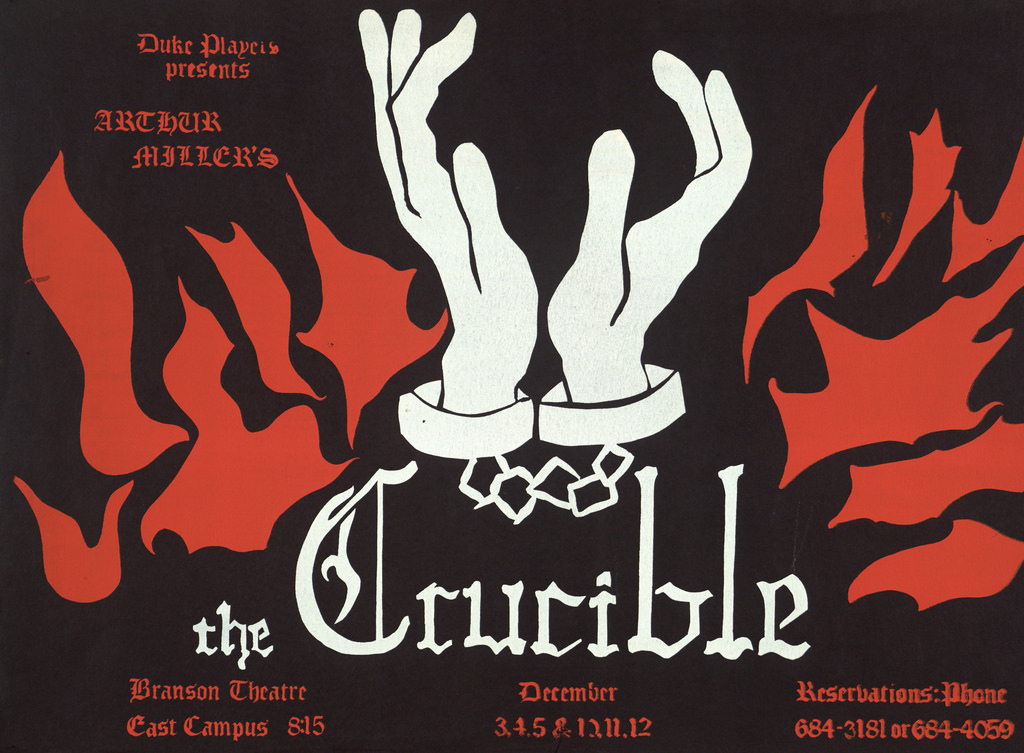Written by Arthur Miller, The Crucible is one of the most popular historical dramas — and recent movie– the world has ever seen. The award-winning movie teaches modern high school students invaluable morals and emphasizes sensitive issues of the the past — such as the role of religion and politics — that are still relevant to the present society.
The Crucible takes place in Salem, Massachusetts, and focuses on the mass hysteria surrounding the Salem Witch Trials. Set in the 17th Century, the play allows audiences of all ages to step into a strict Puritan world and experience firsthand the love, hate, deceit, and jealousy that was behind the ordeal. The movie begins when the town minister Reverend Parris discovers his daughter Betty and his niece Abigail dancing in the woods with his slave, Tituba. Knowing that they have commited a sin, the girls say that they were bewitched by Tituba. Rumors of witchcraft quickly engulf the town as the townspeople gather around the Parris home. Reverend Hale, an expert on witchcraft, is quickly sent for, as Abigail tells the rest of the girls not to say anything.
In that time, Abigail ends up alone with John Proctor, a farmer in the town of Salem, and the man Abigail is rumored to have an affair with. Abigail confides in Proctor and tells him that the girls were just dancing. Under threat of punishment if she refuses to confess, Tituba admits to being friendly with the devil and begins to name other witches in the town. Abigail, seeing this as her way out, begins naming names as well, and the rest of the girls join in. As the lies spiral, a fallacious story is birthed and leads to the heartbreaking death of 20 innocent people, including that of John Proctor.
On October 21, 1996, Arthur Miller wrote Why I Wrote The Crucible: An Artist’s Answer to Politics for The New Yorker, in which he compares the events of Salem Witch Trials to the Red Scare and the similar hysteria that both of these events created. As someone who lived through the Red Scare, Miller was able to write a piece that compared it with the Salem Witch Trials in 1953.The article highlights the paranoia that filled the hearts of Americans in 1949 when Mao Zedong took power in China, and how the Communist Party continued to grow in Western Europe in the 1950’s. Miller also compares details of his play and the events that unfolded in this time period such as “… how the State Department proceeded to hound and fire officers who knew China, its language and it’s opaque culture,” to the trial and prosecution of the women who simply knew the ‘bewitched’ girls.
Miller compared The Crucible to events that were relevant in his lifetime, like the Red Scare. In the 21st century, Americans can still relate to the fear that the town of Salem felt. America is a country consumed with fear: all you need to do is turn on the news channel or check social media to see any number of horrifying stories and the inherent need to find someone to blame for them. Just a few days ago, a video of a police officer using excessive force in an attempt to arrest a 14-year-old girl surfaced. In this case, the police department released a statement that shifted the blame onto the teenage girl. This is just one example of the headlines Americans see everyday. This fear – just like the fear in Salem – creates critical issues in our society, such as transphobia, racism and islamophobia. Fear is a powerful feeling that can immensely affect our actions, and often those actions are made without a second thought, therefore it can lead to violent actions and issues. Puritan values are the stimulation for the destruction of Salem as the urge to expose and destroy the evil creates a much deeper loss of morality then any case of witchcraft. At one point, Deputy Governor Danforth (leading judicial figure overseeing the Salem trials) states in the play, “I should hang ten thousand that dared to rise against the law…” which could easily come from a number of global community leaders today.
Traumatic events in today’s day and age, like those in Salem, allow for false claims to hinder the truth. Mary Warren (who was part of the bewitched girls, but eventually comes clean), states at one point of the play, “… and you, Your Honor, you seemed to believe them, and I– it were only a sport in the beginning, sir, but then the whole world cried spirit,” which can only highlight how easily the opinions of the people can shift in the weight of hysteria. It is argued that one of the most recent cases of mass hysteria was the Ebola crisis, and the resulting shift of opinions on modern medicine, especially regarding the effectiveness.
The Crucible is a play based off historical events that unfolded in the town of Salem that highlights the effects of hysteria and explores the fear that can create critical issues in a society. Examples of this include the Ebola outbreak, the West Bank Fainting Epidemic and the Borneo Kidnapping Scare. Due to events similar to the ones mentioned before, The Crucible is one of the few period plays that still feels contemporary on a global scale.

Leave a Reply